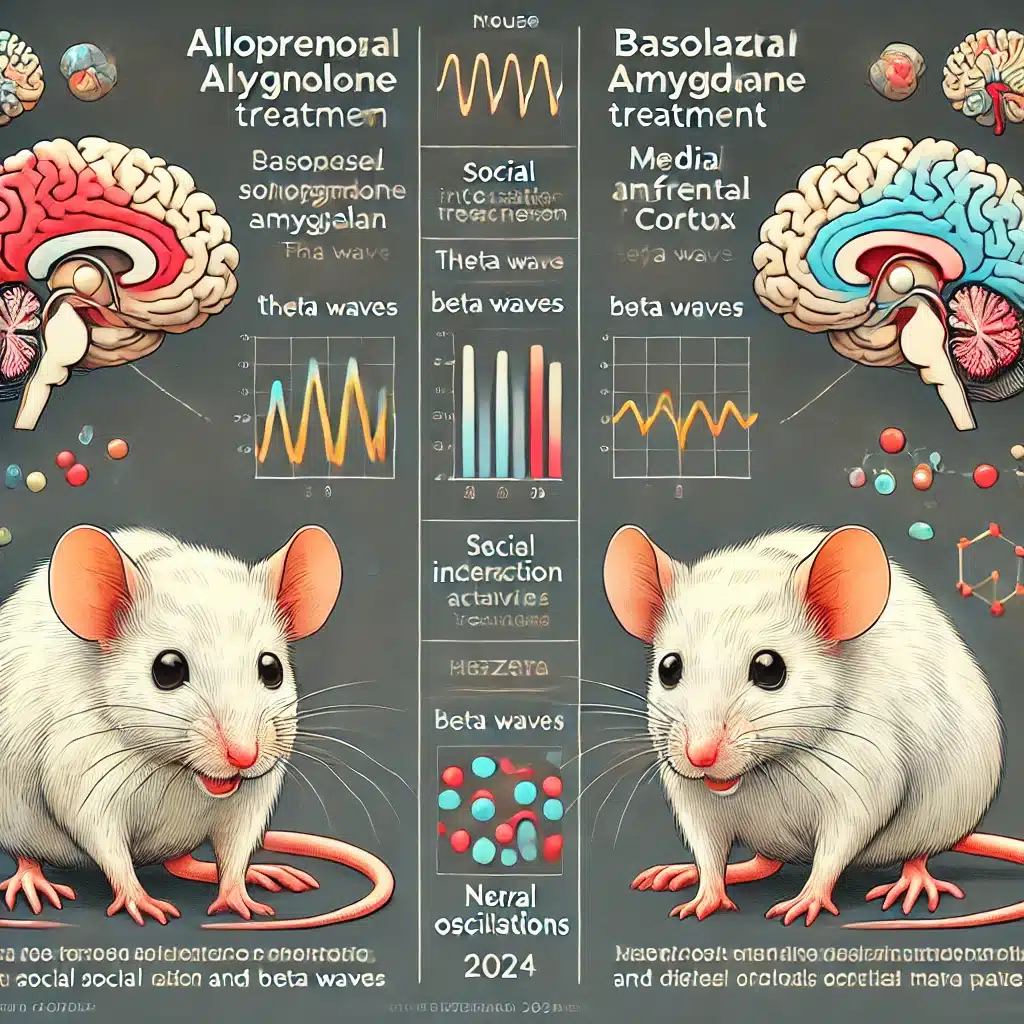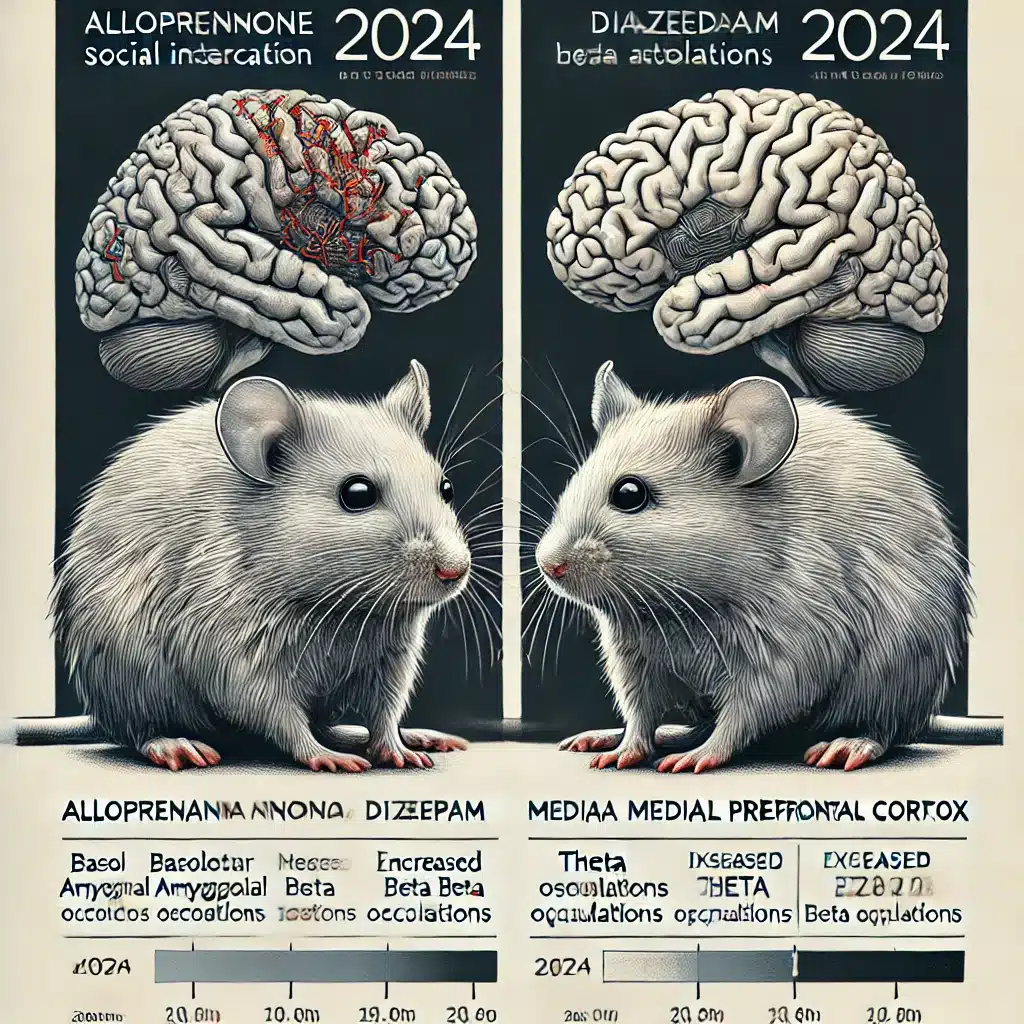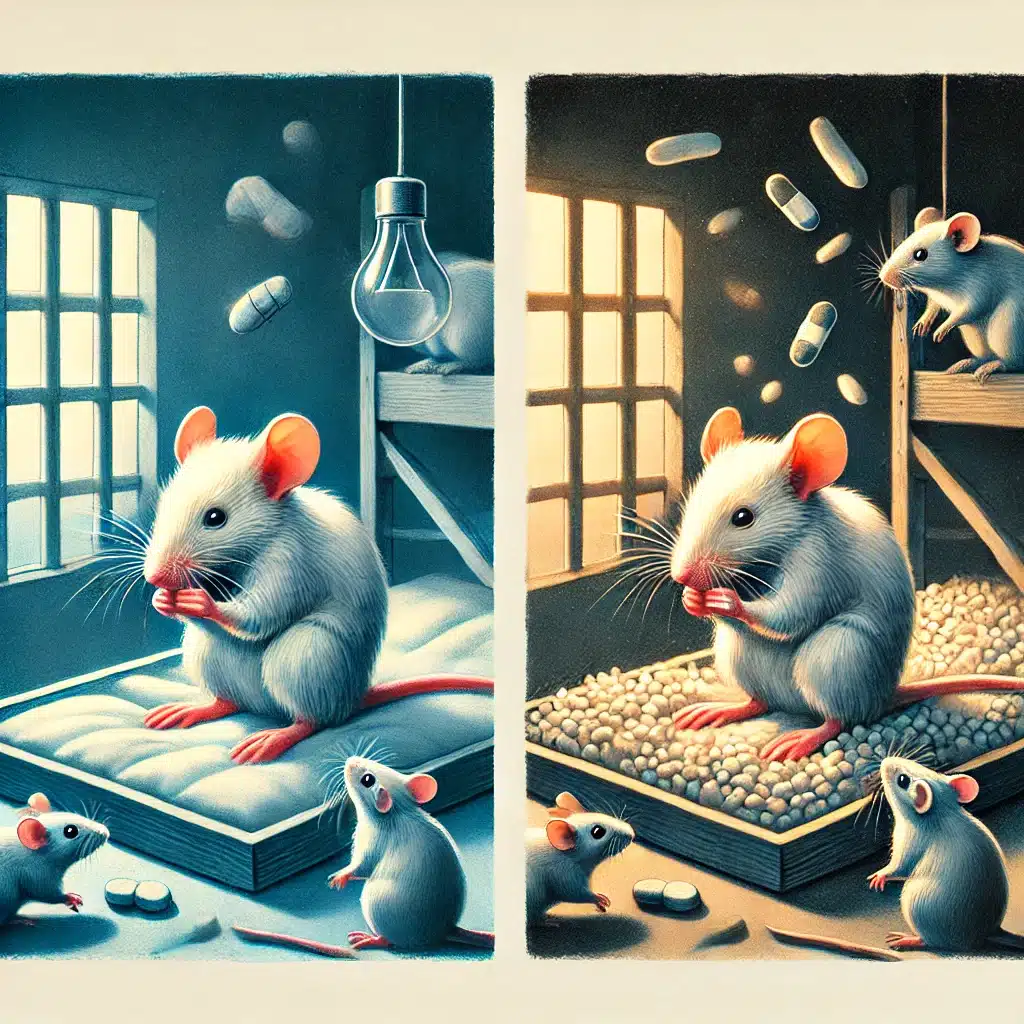Allopregnanolone shows antidepressant-like effects in mice by increasing social interaction and specific brain wave activities, unlike diazepam.
Highlights:
- Allopregnanolone: Allopregnanolone, a neuroactive steroid, increases social interaction time in mice experiencing social defeat stress, indicating potential antidepressant-like effects.
- Brain Activity: This increase in social interaction is associated with heightened theta and beta oscillations in the basolateral amygdala (BLA) during interactions.
- Diazepam: Unlike allopregnanolone, diazepam does not produce the same changes in brain activity or social interaction, highlighting different mechanisms of action.
- Neural Coordination: Allopregnanolone decreases theta-band coordinated activity between the BLA and medial prefrontal cortex (mPFC) at the onset of social interactions, which may reduce negative emotional processing.
- Therapeutic Potential: These findings suggest that neuroactive steroids like allopregnanolone could be promising treatments for major depressive disorder by modulating specific brain wave activities.
Source: Frontiers in Cell Neuroscience (2024)
Major Findings: Allopregnanolone & Diazepam vs. Social Behavior in Mice (2024)
1. Allopregnanolone Increases Social Interaction Time
Antidepressant-like Effects: Allopregnanolone significantly increases the time mice spend in social interaction, suggesting strong antidepressant-like effects. This effect was observed in mice subjected to social defeat stress, a model for depression.
Dose-Dependence: The effectiveness of allopregnanolone is dose-dependent. A higher dose (20 mg/kg) resulted in significant increases in social interaction time compared to a lower dose (10 mg/kg) and diazepam.
2. Unique Brain Activity Patterns
Theta & Beta Oscillations: During social interactions, mice treated with allopregnanolone exhibited increased theta (6-12 Hz) and beta (15-30 Hz) oscillations in the basolateral amygdala (BLA). This specific pattern of brain wave activity was not seen with diazepam or vehicle (control) treatment.
Correlation with Interaction: The increase in theta and beta power in the BLA positively correlated with the total time mice spent in social interactions. This means the more these brain waves increased, the more the mice interacted socially.
3. Changes in Neural Coordination
BLA & mPFC Coordination: The study found that allopregnanolone decreases theta-band coordinated activity between the BLA and the medial prefrontal cortex (mPFC) during social interactions. This reduction in synchronized activity suggests a unique neural mechanism underlying the antidepressant-like effects of allopregnanolone.
Implications for Emotion Regulation: The decrease in theta-band coordinated activity between the BLA and mPFC might help reduce negative emotional processing, such as anxiety and fear, which are often elevated in depression.
4. Distinct Mechanisms from Diazepam
No Similar Effects with Diazepam: Diazepam, a common benzodiazepine, did not produce the same increases in social interaction or changes in brain activity as allopregnanolone. This indicates that the mechanisms through which allopregnanolone and diazepam act are fundamentally different.
Focus on Extrasynaptic GABAA Receptors: The distinct effects of allopregnanolone are likely due to its action on both synaptic and extrasynaptic GABAA receptors, whereas diazepam primarily affects synaptic GABAA receptors.
5. Potential for New Depression Treatments
The study’s findings suggest that neuroactive steroids like allopregnanolone could be a promising new class of treatments for major depressive disorder (MDD), especially by targeting specific brain wave activities and neural coordination patterns.
Potential Translation to Human Application

1. Potential for New Depression Treatments
Novel Antidepressants
The findings suggest that neuroactive steroids like allopregnanolone could be developed into effective antidepressants for humans.
These drugs target both synaptic and extrasynaptic GABAA receptors, offering a different mechanism from traditional benzodiazepines.
Regulation of Brain Activity
By increasing theta and beta oscillations in specific brain regions, allopregnanolone could help regulate the neural circuits involved in mood and social behavior, potentially improving symptoms of depression.
2. Mechanism of Action
Targeting GABAA Receptors
The dual action on synaptic and extrasynaptic GABAA receptors suggests a broader and possibly more effective modulation of brain activity in depression.
This could lead to improved treatment outcomes compared to drugs that target only synaptic receptors.
Reducing Negative Emotional Processing
The observed decrease in theta-band coordinated activity between the BLA and mPFC in mice could translate to reduced rumination and negative emotional processing in humans, helping to alleviate symptoms of depression.
3. Implications for Human Brain Activity
Brain Wave Modulation
The correlation between increased theta and beta oscillations and improved social behavior in mice indicates that similar brain wave modulation in humans could enhance social interactions and overall mood.
Neural Coordination
The study’s findings on the coordination between the BLA and mPFC highlight the importance of these regions in emotional regulation.
Targeting these pathways could provide new strategies for treating depression.
4. Clinical Considerations
Dosage & Administration
Further research is needed to determine the optimal dosage and administration methods for allopregnanolone and similar compounds in humans.
This includes understanding the long-term effects and potential side effects.
Patient Selection
Identifying which patients would benefit most from neuroactive steroids, based on their specific neural activity patterns, could personalize and improve treatment efficacy.
Comparative Studies
Additional studies comparing neuroactive steroids with existing antidepressants will be crucial to establish their relative effectiveness and safety profiles.
Study Details: Antidepressant-Like Effects of Allopregnanolone (2024)

The study aimed to investigate the antidepressant-like effects of allopregnanolone by examining its impact on social interaction and associated neuronal activity patterns in mice subjected to social defeat stress.
Sample
- Animals Used: The study involved male C57BL/6J Jcl mice as the test subjects and larger male ICR mice for inducing social defeat stress.
- Age and Weight: Test mice were aged 2-4 months and weighed between 20-30 grams.
Methods
- Social Defeat Stress (SDS) Model: Mice were subjected to a 10-day social defeat stress procedure to induce depression-like behaviors.
- Social Interaction Test (SIT): After SDS, the mice’s social interaction behavior was assessed by placing them in an open field with an unfamiliar mouse enclosed in a plastic box.
- Drug Administration: Mice were administered either vehicle (control), diazepam (2 mg/kg), or allopregnanolone (10 mg/kg or 20 mg/kg) intraperitoneally before conducting the SIT.
- Electrophysiological Recording: Local field potentials (LFPs) were recorded from the basolateral amygdala (BLA) and medial prefrontal cortex (mPFC) during the SIT to analyze neuronal oscillations and their correlation with social behavior.
Limitations
- Sample Size: The study was conducted on a limited number of mice, which may affect the generalizability of the findings.
- Specificity to Mice: The results obtained from mouse models may not directly translate to humans due to species differences.
- Scope of Neural Dynamics: The study focused primarily on theta and beta oscillations, potentially overlooking other relevant neural dynamics and regions involved in antidepressant effects.
- Temporal Dynamics: The precise timing and duration of observed effects were limited to the specific conditions of the SIT, which may not capture the full spectrum of allopregnanolone’s impact on brain activity and behavior.
Conclusion: Allopregnanolone & Social Behavior
This study demonstrates that allopregnanolone, a neuroactive steroid, significantly enhances social interaction in mice subjected to social defeat stress, indicating strong antidepressant-like effects.
These effects are linked to specific increases in theta and beta brain wave activities in the basolateral amygdala, which are not observed with diazepam, a common benzodiazepine.
The findings suggest that allopregnanolone and similar compounds could offer novel treatments for major depressive disorder by targeting both synaptic and extrasynaptic GABAA receptors.
Further research is needed to translate these findings to human applications, potentially leading to more effective and personalized depression therapies.
References
- Study: Differential effects of allopregnanolone and diazepam on social behavior through modulation of neural oscillation dynamics in basolateral amygdala and medial prefrontal cortex (2024)
- Authors: Yosuke Yawata et al.







